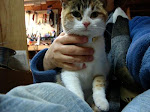Ok, admit it. You thought it bizarre and possibly even disgusting that I do not change my chickens' litter as often as I change the cats' litter. The truth is that changing the litter often is not as healthy for the birds as our false-sanitation obsessed culture would have you believe. For one thing, the birds hate it. They get all in a tizzy for three days or so when I go messing about with their house.
What about the stink?
There isn't any. Mr. Fuzzy would report that pronto!
What about ammonia fumes?
There aren't any unless I get lazy.
What about nasty microbes?
They aren't present in significant quantities.
What about all that built up poo? (!)
It's composting.
Deep litter, or "layered litter" as it was called back in the early 1940's, is a system wherein you build up the litter over the poo, keeping everything well fluffed and limed, until it is at least 12 inches deep. When the final depth is reached any new poop is turned under daily and the whole floor fluffed to encourage good air exchange. The result is that the manure is effectively composted.

In the winter this has the added benefit of making the coop floor nice and warm for the chickens. Even though my flock rarely chooses to spend the day indoors (they go for a walkabout no matter how cold, wet, or snowy it is) they must surely appreciate the warmth, especially the three sorry looking bantys who like to sleep on the floor. We hadn't thought about this until we saw a temperature reading over on the Avian Aqua Miser Chicken Blog.
I know several of you still aren't buying this idea so let me quote from the Ohio Experiment Station's reports of 1948 & 1949. You can read them in their entirety here.
"The prevention or control of coccidiosis by starting day-old chicks on old built-up litter could have been prophesied years ago. It has long been recognized that chicks exposed to small dosages of coccidia at an early age developed a resistance which gave protection against heavier dosages to which they are often exposed from 4 to 12 weeks of age. Built-up litter has thus proved the most practical and effective means by which this resistance can be established."
Coccidiosis is the leading cause of chick death, even now.
Chickens raised on this sort of litter are less prone to cannibalism, gain weight faster even when eating poor quality feed, and hatchability of fertilized eggs is increased. It is theorized that the composting litter adds some positive element to their diet, although the experimenters did not know what. Robert Plamadon suggests it may be an increase of B-12 from bacterial fermentation in the litter. (Yes, folks, the chickens eat a little litter now and then.)
I had wondered how often the layered litter "ought' to be changed and was delighted to read that it's much longer than I'd imagined:
"The same built-up floor litter has been successfully used in brooder houses at the Station’s poultry plant for six succeeding broods of chicks. Likewise, most of the layers are on built-up floor litter that started nearly 3 years ago. Thus far, no disadvantages have been experienced from the long-time use of the litter, either in brooder or laying houses. The older built-up litter is, of course, more effective for the prevention or control of dampness because of its greater depth. It appears the only need for removal is to keep it within convenient bounds."
Mr. Palmadon reports that his results have not been as good as the Ohio results however his system is based on open-air coops and he admits to being a lazy chicken keeper and not keeping up with the fluffing as he should.





1 comment:
Hi! I'm new here, if you want to have a look this is my blog: http://lena510.blogspot.com/
:)
Post a Comment